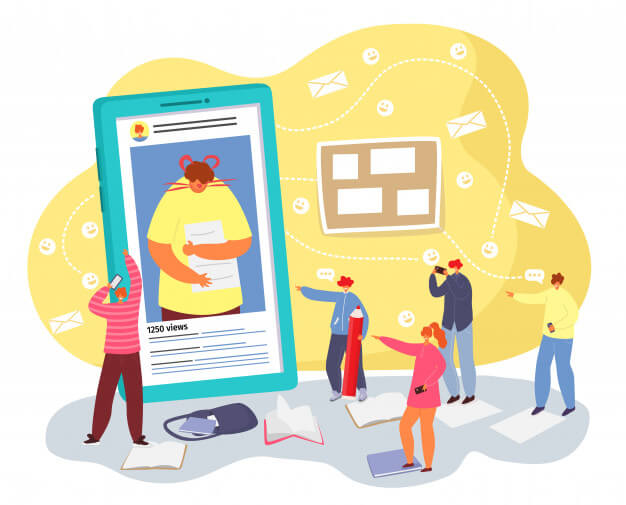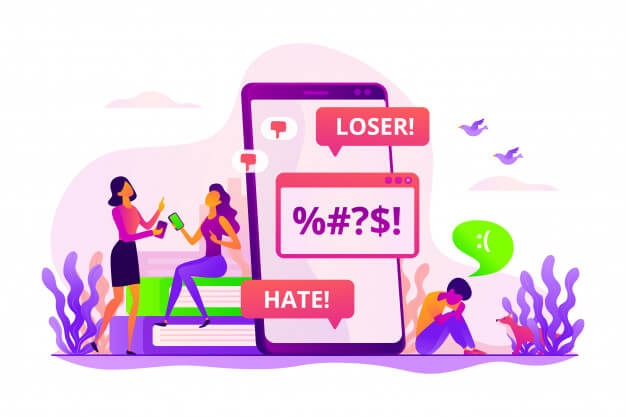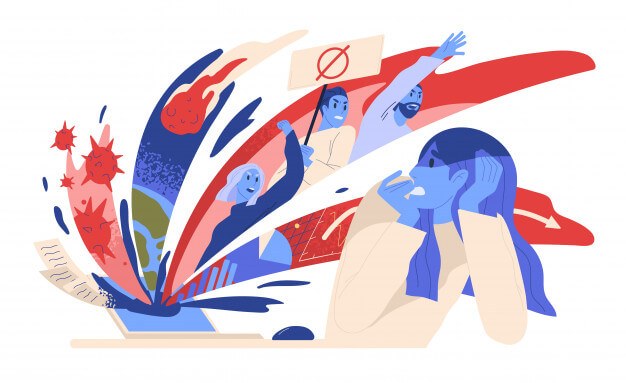Impact of Online Harassment on Mental Wellness | Effective Ways to Deal With It

What is the one thing that we all have access to?
Hint: It connects us all together, no matter how far we are!
The answer is the INTERNET! The Internet connects us all and is easily accessible. That’s not it! It has a lot more to offer, which makes our life easy and convenient! But, is that all? Does the internet have all the sugar spice and everything nice phrase attached to it?
We all know the answer here! NO!!! In fact, the internet has a real dark side of it- Online harassment! And this dark side is proven to take a toll on our mental health! Therefore, it becomes important to keep a check on it, be safe, and deal with it effectively!
Now, if you are thinking that- ‘Oh! I am not going to be affected by it!’ Then, let me provide you a fact here- 1 in 5 people report being harassed on the internet in one or the other manner!
Online Harassment can literally affect anyone and everyone who has access to the internet and social media. Well, who is even missing on these two things in this 21st century?
Although it is found through studies that the majority of online harassment activities are directed towards females and teenagers It doesn’t justify that they are the only going through it.
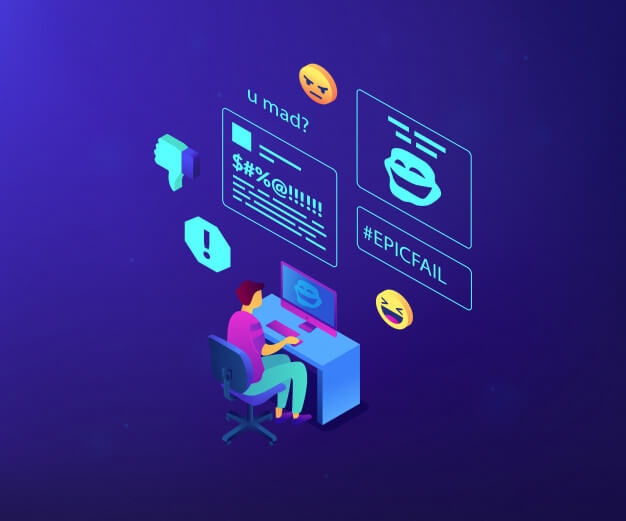
Let us understand this with the help of case studies (real-life based)
Case Study on Online Harassment:
Case Study 1:
Who: Sarah is in her 30s and recently moved in with her partner, Ali.
The Case: She received some strange voicemails from a blocked number, Sarah found out that Ali was still in contact with his ex-wife, Catherine. Ali assured Sarah that Catherine meant her no harm and that the voicemails were probably spam calls. A few weeks after the voicemails, Sarah began receiving threatening emails from Catherine’s account threatening to ‘ruin her life.’ Catherine then hacked into Sarah’s social media accounts. Catherine took some of the images of Sarah (which was a mixture of nude images) and other images to her work colleagues, Ali’s friends, and family members. Later she posted the images via social media and sent some of Sarah became very distressed as some of the images were sexual, and others showed her workplace.
Outcome: Sarah first contacted Facebook and Twitter, and successfully asked them to take down the images, and asked Ali’s family to delete the photos. She contacted the police about the threats and the disclosure of the images, and Catherine was arrested and charged with committing the offense
Case Study 2:
Who: Trevor was a gay man whose Facebook page was hacked by someone who used it to send offensive messages to other people.
The case: The messages sent from Trevor’s Facebook account included information about him being gay, used sexual language, and made explicit sexual references. He changed his password which stopped the messages but another profile was set up in his name to spread false rumors. He contacted Facebook, which deleted the profile, but then another one was set up. This went on for months, with him being distressed that people got to know about his sexuality in a way he hadn’t intended and worried if they would believe the things in the messages.
Outcome: Eventually a colleague at work disclosed that they’d heard another colleague bragging that they were sending the messages. Trevor went to his manager for support who confronted the colleague. Following an investigation by the employer, evidence was found to prove it was the work colleague, who was dismissed. Trevor felt supported by his employer.
Source of case studies: Stop Online Abuse
Here you can see that no matter what age or gender group you come from, everyone with internet access is at equal risk of being exposed to online harassment.
Forms of Online Harassment:
Often one is not even aware of the fact that any form of online harassment is taking place in his/her life. The reason being that we are not well-informed of situations that fall under this umbrella term- online harassment. So, to understand the impact of it on our lives and most importantly our mental health, first let us learn about different forms of online harassment. Time to unwrap the list of types of online harassments:
1. Cyberstalking
A one-word definition for cyberstalking will be- threat. Receiving threats online both directly (to oneself) or indirectly (to loved ones) is found to be one of the most dangerous forms of online harassment.
Is it a crime? Yes, indeed!
So what should I do?
- Warn them and convince them to stop it
- Block the cyberstalker from all the online platforms.
- Keep evidence of your attempt to stop them or warn them
Impersonation
One phrase description of this is masking behind. Here a person uses the name or persona of someone else without their prior consent. The intent behind this is to defraud, harm, or threaten the person whose identity is being stolen.
Is it a crime? Yes, indeed!
So what should I do?
- For your safety maintain adequate theft protection identity on all your devices
- Use safe and secure ways to login your online platforms
- You may also build a case against it
2. Doxxing
It involves sharing someone’s personal information on online sources, without them knowing.
Is it a crime? Yes, if your information is not public (it is private)
So what should I do?
- Keep your data private; make your social media accounts private
- Protect your location through a VPN
- Never share your passwords with anyone
3. Swatting
Making a false report to the police about illegal activities taking place at someone’s home, putting the person swatted and others in danger.
Is it a crime? Yes, indeed!
So what should I do?
- For your safety maintain adequate theft protection identity on all your devices
- Make use of a VPN to protect your IP address
- Take legal action against the culprit
4. Catfishing
Creating a fictitious online identity with the mere purpose to start a relationship.
Is it a crime? Nopes!
So what should I do?
You should look after certain signs like-
- The person will deny to meet you in public at all costs
- The person will be in a rush to take a step-ahead in relationship
- The profile is relatively new with few contacts, incomplete and inconsistent
5. Trolling
Probably the most common form of online harassment in this list! So common that many of us won’t even consider it to be a part of this list.
It is an act of making unsolicited comments targeting someone or a community, on online platforms.
Is it a crime? Nopes! (until it goes to the extreme ends)
So what should I do?
- Instead of responding or provoking the person; block them
- Report them on social media platforms (ask your closed ones to support it as well)
- Report to cybercrime as well
6. Dogpiling
Being bombarded with messages by a mob who completely disagree with your viewpoint. It is also referred to as message bombing and often considered to be a form of trolling.
Is it a crime? Nopes! (until it goes to the extreme ends)
So what should I do?
- Instead of responding or provoking the person; block them
- Report them on social media platforms (ask your closed ones to support it as well)
- Report to cybercrime as well
7. Revenge Porn
It is the act of sharing sexually explicit, disturbing, and private images or videos to someone without their consent.
Is it a crime? Yes, indeed!
So what should I do?
- Contact the platform and ask them to get it removed from there and take action towards that person
- Report them on social media platforms (ask your closed ones to support it as well)
- Report to cybercrime as well; take legal action
8. Cyberbullying
Cyberbullying is the all in one ugly package of online harassment! Cyberbullies make use of all sorts of electric communication to harass someone.
Is it a crime? Yes, indeed!
So what should I do?
- Stop sharing your identifying information
- Make use of adequate theft protection identity on all your devices
- Report them on social media platform and to law enforcement
9. Hate Speech
Free speech is one of our rights but on online platforms, under the light of freedom to speech, it takes a whole different flip and turns to hate speech.
Is it a crime? Not really! Until and unless it breaks any law/section.
So what should I do?
- Instead of responding or provoking the person; block them (immediately)
- Report them on social media platforms (ask your closed ones to support it as well)
- Report the person to law enforcement
Impact of Online Harassment on Mental Health:
Allison Abrams says, “when our sense of emotional safety in the world is compromised, so too is our psychological health.” This holds true in cases of online harassment.
Irrespective of the form of online harassment, each one of them is found to have an impact on our mental health. Though some of the online activities might sound harmless or even mischievous to the perpetrator, they do have a far-reaching and long-lasting impact on the mental well-being of the victim.
Recent research in the Journal of Clinical Psychiatry found that online harassment can induce symptoms of depression and posttraumatic stress disorder in those who are exposed to it. This further creates a vicious cycle, further leading to anxiety and stress.
Distress that online harassment accompanies is found to lower down one’s performance at school, work, and life in general. Along with this, feelings of fear, helplessness, low self-esteem are likely to follow (as supported by a 2017 study). The emotions become so overwhelming that victims find it difficult to even get help for the same.
How to DEAL with Online Harassment?
The first step in dealing with online harassment is weighing up the severity of the attack. Basically, if it’s a low level then avoidance or blocking might help. But if it is at a higher level or out of proportion then actions are required, and avoidance won’t help.
The next step is, start helping yourself!!! Here are two ways in which you can help yourself: digital shield and psychological armor.
1. Digital Shield
The source of online harassment is the digital world so the first way to help yourself is to create a digital shield to fight against it.
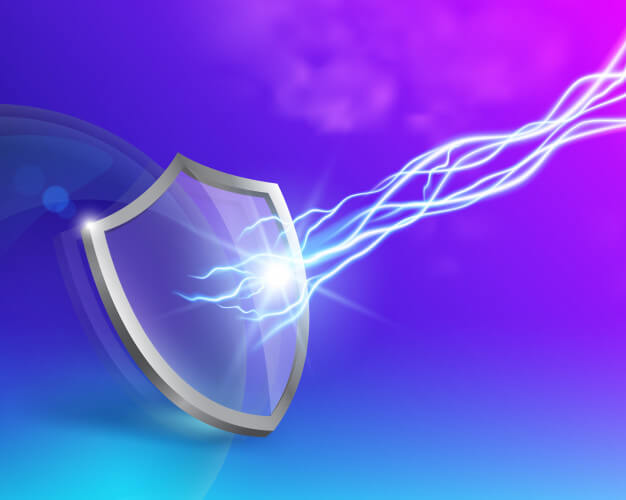
Here are some ways to create this digital shield:
- Report and Block Immediately:
The first thing that you should do is report and block the user straightaway. This will stop further activities on part of that individual thus, reducing your source of distress.
- Ask you closed ones for the same
Remember you are not alone in this! Your social support circle is there with you in this battle. So, reach to them and ask them to do the same, that is, report and block the person. With multiple reports the likelihood of the account being deleted by the platform itself increases. Thus, eradicating the root cause.
- Make use of Law and Order:
From the above write-up, you can easily make a note of one thing, that you can always report and take legal actions towards such situations. So, don’t be laid back, if it is really hurting you, raise your voice and make use of laws
- Never delete the evidence:
If you have ever watched any detective series you might be aware of the fact that a piece of evidence is far more powerful than 1000 words in criminal acts. You have to make a note of the same! Don’t delete any piece of evidence, no matter how obnoxious it is, just take a screenshot.
- Stop posting identifying information:
The moment when the first instance of online harassment takes place stop sharing your identifiable information such as geolocations. This might make it easier for the cyberbully to track you down, making situations even worse.
- Don’t respond:
As the saying goes… “don’t feed the trolls,” just try and abide by the same. Trollers and cyber haters are there to get a response from your end so that they know they have hurt you and get pleasure from it. So, give them the opposite here, that is, offer them silence instead of reaction. This will show them their failure!
- Take a break
Turn your notifications off, turn your phone and other digital devices off. This will keep you detached from the online world for a while and put the trolls shout into the ether.
2. Psychological Armour
Half of our strength comes from our mental health.
So here are some ways to get your psychological armor and be strong under these situations:
- Open Up:
Tell your family and friends about what kind of online harassment has taken place in your life and open up about your feelings to them. Seeking social support can feed you with an act of kindness that will boost your entire body.
- Book an Appointment:
If the emotions and distress related to the online harassment incident go beyond control or are really overwhelming then booking an appointment with a mental health practitioner is definitely recommended. You may find other effective ways to cope with the given situation.
- Connect Offline:
With the online world creating chaos and distress take a moment and connect offline. The good vibes that you will get through connecting to your peer support group face-to-face will make you feel better altogether.
- Don’t Blame Yourself:
Remember you weren’t the person with wrong intentions. Neither were you able to predict the possible outcomes at that given point of time. So, stop blaming yourself. In fact, under these situations, you should be more confident in yourself.
- Take Care of Yourself:
Amid all the distress don’t forget to take care of yourself. As mentioned earlier, you are your strongest support system at this time, so take care of yourself. Keep yourself full and hydrated.
P.S. don’t cut on your sleep!
Be Compassionate Towards Self
It might seem difficult at the moment to have control over your feelings. But, instead of fighting with yourself, be compassionate, that’s the best you can do.
Being Someone Else’s Knight in the Shining Armor
If you know someone who’s going through online harassment or is trying to recover from one such incident then, be with them and support them. Try to communicate these measures with them and help them through these difficult times.

Parents Role in Online Harassment
With nearly 48% of online harassment cases being reported by teenagers, it is important for parents to be their shield and make sure that their child is safe and sound. Two important aspects that parents should consider here are- Checking for the signs of a kid going through any form of online harassment and being their shield and support system.
1. Look for the SIGNS
A study found that over half of young people don’t share the instances of online harassment with their parents. So as a parent, you have you to proactively look at the following signs:
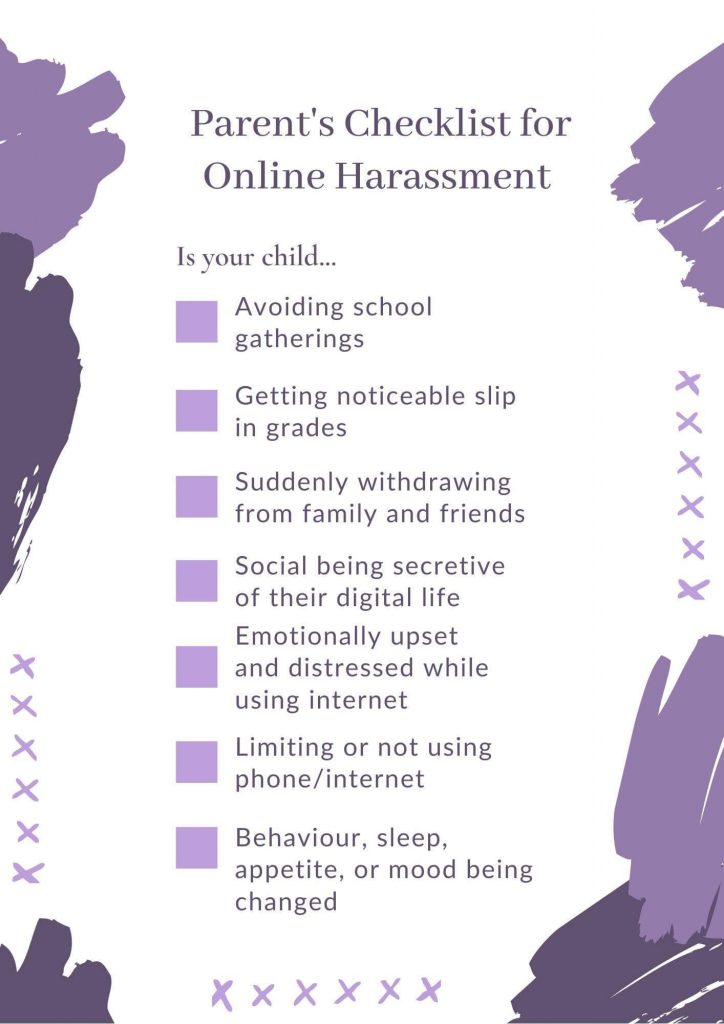
2. Being the COMFY CUSHION
If you see a few or even one of these signs in your child then it is important to address the issue and help them through this rough patch. Here are some effective measures that you can consider:
1. Trust Your Child:
If you don’t trust the story of your child and understand the ill effect of online harassment on his/her physical and mental health you won’t be able to protect him/her. So, the first thing that you have to do is TRUST your child. Sit with them, talk to them and most importantly listen to them. Make them feel that you are their safe place and comfy cushion on which they can rely on.
2. Be Well Informed:
It is important to have proper, legit, and right information pertaining to online harassment. Only if you have proper knowledge about it will you be aware of your rights and will be able to build a case against it.
3. Knock at the School Doors:
With many cases of online harassment in teenagers and adolescents being directed towards victims by a school buddy, it is important to reach your child’s school. Not only schools nowadays have anti-bullying policies but they can also help the child deal with online harassment, through proper counseling and care.
4. Track Down the Bully:
Be Sherlock Holmes for your child! What I am trying to say is, investigate closely who the bully is and block them down through your child’s social media handles. You may also report them.
This way you can help yourself and protect your child from the increasing rate of online harassment and its ill effects.

Inspirational Ted Talks
Ted Talks have always been a source of inspiration. They can actually help in uplifting you in situations of online harassment as well. Here, sharing two such videos with you. Enjoy and get inspired.
Video 1: There is nothing virtual about online trolling | Ginger Gorman | TEDxCanberra
Video 2: What internet trolls taught me | Hannah Witton | TEDxClapham
A note to harassers:
Make love, not war. Treat others as you’d like to be treated. Divert your energy and use it for good. Also, find a positive and healthy hobby to occupy your time and lead a happy life.

Source: Instagram
Take home message:
No matter whether it is you or a closed one who is facing online harassment or overcoming it, it is important to deal with the given situation in a healthy manner. Never… I repeat never let the virtual world take a toll on your real health and happiness.
More power to you…
P.S. If you want to ask any question or have an input on online harassment to share with us, just drop it down in the comment section!!!

